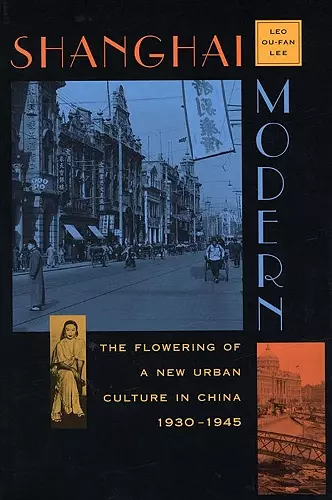Shanghai Modern
The Flowering of a New Urban Culture in China, 1930–1945
Format:Paperback
Publisher:Harvard University Press
Published:1st Oct '99
Currently unavailable, and unfortunately no date known when it will be back

This is cultural history from inside out and from ground up. Lee reads the semiotics of Shanghai modernism with a stunning sensibility that evokes a cosmopolitan past when city streets were scenes of poetry rather than protests and when urban experience redefined the meaning of femininity. A major statement towards a new cultural history of modern China. -- Wen-hsin Yeh, University of California, Berkeley This is the definitive study of the making of modern Shanghai. Leo Lee has remapped Shanghai's cultural geography, marking out the intricate relations between city and coloniality in the 1930s. Admirably combining historical rigor with literary sensibility, it adumbrates an alternative style of cultural criticism for the new century. -- David Wang, Columbia University The special flavor of prewar Shanghai emerges from these pages. Shanghai Modern is immensely rich in theoretical insights, and they emerge out of the dense, living portrait of old Shanghai, with its literary circles, dance-halls, movie theatres, facades, and streets. Lee makes you see how modern consciousness only exists in the circulation of forms, images, and ideas. The process is laid out before us in this rich and subtle description of the key epoch in the life of this tragic metropolis. -- Charles Taylor, McGill University
Leo Ou-fan Lee gives us a wide-angle view of Shanghai culture in the making. He shows us the architecture and urban spaces in which the new commercial culture flourished, then guides us through the publishing and filmmaking industries that nurtured a whole generation of artists and established a bold new style in urban life known as modeng.
In the midst of China’s wild rush to modernize, a surprising note of reality arises: Shanghai, it seems, was once modern indeed, a pulsing center of commerce and art in the heart of the twentieth century. This book immerses us in the golden age of Shanghai urban culture, a modernity at once intrinsically Chinese and profoundly anomalous, blending new and indigenous ideas with those flooding into this “treaty port” from the Western world.
A preeminent specialist in Chinese studies, Leo Ou-fan Lee gives us a rare wide-angle view of Shanghai culture in the making. He shows us the architecture and urban spaces in which the new commercial culture flourished, then guides us through the publishing and filmmaking industries that nurtured a whole generation of artists and established a bold new style in urban life known as modeng. In the work of six writers of the time, particularly Shi Zhecun, Mu Shiying, and Eileen Chang, Lee discloses the reflection of Shanghai’s urban landscape—foreign and familiar, oppressive and seductive, traditional and innovative. This work acquires a broader historical and cosmopolitan context with a look at the cultural links between Shanghai and Hong Kong, a virtual genealogy of Chinese modernity from the 1930s to the present day.
Lee is at his strongest in discussing the inter-textuality of the various works he discusses in this section of the book, showing their relationship to both the European and Chinese literary traditions… Lee’s focus on republican-era Shanghai is a reminder of the renewed capacities of China’s largest city as a producer of the discourse of modernity in the post-Mao era. -- Antonia Finnane * Left History *
The special flavor of prewar Shanghai emerges from these pages. Shanghai Modern is immensely rich in theoretical insights, and they emerge out of the dense, living portrait of old Shanghai, with its literary circles, dance-halls, movie theatres, façades, and streets. Lee makes you see how modern consciousness only exists in the circulation of forms, images, and ideas. The process is laid out before us in this rich and subtle description of the key epoch in the life of this tragic metropolis. -- Charles Taylor, McGill University
This is the definitive study of the making of modern Shanghai. Leo Lee has remapped Shanghai’s cultural geography, marking out the intricate relations between city and coloniality in the 1930s. Admirably combining historical rigor with literary sensibility, it adumbrates an alternative style of cultural criticism for the new century. -- David Wang, Columbia University
This is cultural history from inside out and from ground up. Lee reads the semiotics of Shanghai modernism with a stunning sensibility that evokes a cosmopolitan past when city streets were scenes of poetry rather than protests and when urban experience redefined the meaning of femininity. A major statement towards a new cultural history of modern China. -- Wen-hsin Yeh, University of California, Berkeley
- Nominated for Harry J. Benda Prize 2002
ISBN: 9780674805514
Dimensions: unknown
Weight: 562g
464 pages